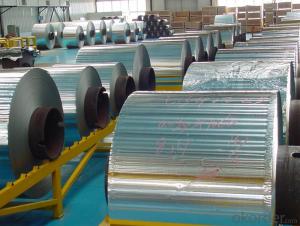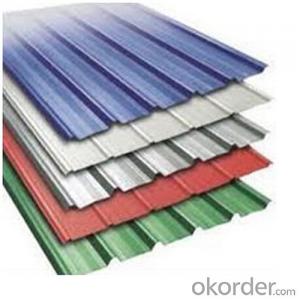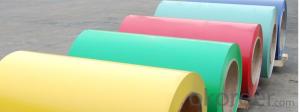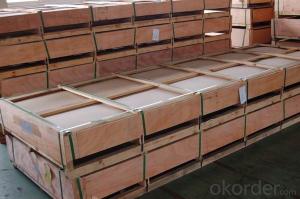Aluminum Coils 3003 for insulation and cladding of oil & gas pipes
- Loading Port:
- Shanghai
- Payment Terms:
- TT OR LC
- Min Order Qty:
- 25 m.t.
- Supply Capability:
- 20000 m.t./month
OKorder Service Pledge
OKorder Financial Service
You Might Also Like
1.Structure of Aluminum Coils 3003 For Cladding Description
Aluminum Coils 3003 has great ductility, heat conductivity, anti-corrosion and moisture resistance properties.
Aluminum Coils 3003 is widely used for insulation and cladding of oil & gas pipes.
2.Main Features of the Aluminum Coils 3003
• Superior quality of raw material
• Reasonable and stable chemical composition
• Accurate tolerance
• Good mechanical property
3. Aluminum Coils 3003

4. Aluminum Coils 3003 Specification
Alloy | AA3003 |
Temper | H14, H16, H18, H22, H24, H26, H32, O/F |
Thickness | 0.2mm -- 100mm |
Width | 30mm -- 1700mm |
Standard | GB/T 3880-2006,EN,ASTM,JIS |
5. FAQ of Aluminum Coils 3003
A.How to guarantee the quality?
Customers are welcome to our mill to visit and check the products. Besides, we can arrange a third party to test the quality.
B.When will you deliver the products?
The aluminum will be delivered within 35 days after receiving advanced payment or original L/C.
C. Now which countries do you export your goods?
Now we export to South East Asia,Africa, North America,South America ect.
- Q:I've narrowed down my next bike next year to either the cannondale Caad10 Ultegra version or the supersix 105 version, I've heard good things about both bikes, and at this point its gonna be down to preference after I ride it but, is aluminum stronger than carbon or vice versa? Will carbon crack easily or fail catastrophically?
- I am not sure where some of these posts came from, but from someone like myself who road cycles 6000 to 8000 miles per year and has a 3 year old carbon fiber frame, I have never had any problems with my frame... I have never heard of any carbon bike breaking unless it was in some MAJOR crash... the same crash that would destroy almost any bike (except cromealloy steel)... That being said, carbon frames are usually the lightest out there, but they can be pricey. Yes, they can be stiffer, but that is a GOOD thing because the power transfer through the drivetrain is better, especially when you have to get up out of the saddle. While riding regularly, especially on the flats, it gives a bit, providing a plush ride. I love my Specialized Roubaix Pro, pretty much everything on the bike is carbon, from the FSA cranks to the Specialized carbon stem... But be prepared to spend at least 3000 bucks to get the bike with good components. Ride safe and have fun!
- Q:I recently moved into a 1975 house with aluminum wiring. I will be going through and checking/replacing all receptacles and switches with CO/ALR rated ones as I don't have a budget right now to rewire the house. I am wondering if I should be checking all of the ceiling lights as well as some of them would be very difficult to access. Are lights as big a concern with aluminum connections as receptacles? I am sure some of the lights are newer and would have copper wire connected to the aluminum. Should I be concerned about the type of wire nuts used here?Anything else that I should be checking?
- There's no problem with aluminum wiring that would require you to rewire your house as long as the proper wire gauge was used. You should replace all of the receptacles and switches with ones rated CO/AL. For lighting, replace the wirenuts with ones rated CO/AL and you'll be fine. From what I remember, Aluminum has a higher resistance than copper so it requires 1 size larger conductors. Aluminum also oxidizes faster than copper. If you have aluminum wires in your panel you should turn the main service disconnect off and put some de-oxidizer (you can find it at home improvement stores in the electrical section) where the wire lug is. This oxidation can make a bad connection causing you to lose voltage as the resistance goes up raising the amperage. This will generate more heat. Aluminum also... well its hard to explain... A/C current cycles its power in a sin wave, it causes the wire to vibrate. You will have to tighten all of the lugs on your electric panel periodically. The CO/AL wirenuts and receptacles/switches help prevent the vibration from loosening the connections causing a short and possibly a shock hazard or even a fire.
- Q:Are 101 aluminum sheets suitable for outdoor signage?
- Yes, 101 aluminum sheets are suitable for outdoor signage. They are corrosion-resistant, durable, and can withstand various weather conditions, making them a suitable choice for outdoor applications.
- Q:Are the aluminum sheets suitable for manufacturing aircraft fuselages?
- Yes, aluminum sheets are suitable for manufacturing aircraft fuselages. Aluminum is widely used in the aerospace industry due to its excellent strength-to-weight ratio, corrosion resistance, and easy formability. It provides structural integrity while keeping the weight of the fuselage low, making it an ideal material choice for aircraft manufacturing.
- Q:What is the elongation percentage of 101 aluminum sheets?
- The elongation percentage of 101 aluminum sheets refers to the amount of deformation or stretching the material can undergo before breaking. The exact elongation percentage of 101 aluminum sheets can vary depending on various factors such as the thickness of the sheets and the specific manufacturing process. However, in general, 101 aluminum alloy is known for its excellent formability and high elongation properties. It typically exhibits elongation percentages ranging from 10% to 30%, which means the material can stretch by that percentage of its original length before fracturing.
- Q:How can I make aluminum oxide?
- Visit this link: okorder ... Hope it's useful to you!
- Q:Are aluminum sheets suitable for aircraft panels?
- Indeed, aircraft panels can be made from aluminum sheets. The aviation industry extensively employs aluminum due to its exceptional strength-to-weight ratio, rendering it an ideal choice for constructing aircraft structures that are both lightweight and robust. Aluminum sheets are frequently utilized for aircraft panels owing to their durability, resistance to corrosion, and ease of fabrication. Moreover, aluminum can be effortlessly molded and welded, enabling the creation of intricate panel shapes. Furthermore, aluminum possesses commendable electrical conductivity, a crucial factor in the efficient operation of diverse aircraft systems. In summary, the utilization of aluminum sheets for aircraft panels plays a pivotal role in ensuring the aircraft's structural integrity and performance.
- Q:What is the hardness rating of 101 aluminum sheets?
- The hardness rating of 101 aluminum sheets can vary depending on several factors, such as the alloy composition, heat treatment, and manufacturing processes. However, in general, aluminum alloys are known for their relatively low hardness compared to other metals. The Rockwell hardness scale is commonly used to measure the hardness of metals, but it is not typically applied to aluminum. Instead, the Brinell or Vickers hardness tests are more commonly used for aluminum alloys. Without specific information about the alloy composition and any specific heat treatment applied to the 101 aluminum sheets, it is difficult to provide an exact hardness rating. Therefore, it is recommended to consult the manufacturer or supplier of the specific 101 aluminum sheets for accurate hardness information.
- Q:What are the different methods of surface printing aluminum sheets?
- Aluminum sheets can be surface printed using various methods, each with its own advantages and applications. Some commonly used techniques include: 1. Screen Printing: This technique involves using a mesh screen with a stencil to transfer ink onto the aluminum sheet. It offers precise printing and vibrant colors, making it suitable for signage, labels, and decorative purposes. 2. Digital Printing: Advancements in technology have made digital printing popular for aluminum sheet printing. It directly prints the design onto the sheet using inkjet technology, offering high detail and a wide range of colors for customized and complex designs. 3. Offset Printing: This versatile method transfers the design from a plate onto a rubber blanket, which is then pressed onto the aluminum sheet. It provides consistent and accurate printing results, often used for packaging, labels, and large-scale printing. 4. Flexographic Printing: This cost-effective method uses flexible relief plates to press the desired design onto flexible materials like aluminum sheets. It is suitable for large-scale production and commonly used for packaging materials and labels. 5. Gravure Printing: Also known as rotogravure printing, this method uses engraved cylinders to transfer ink onto the aluminum sheet. It is known for its high quality and ability to reproduce fine details, often used for high-end packaging, decorative items, and high-resolution images. 6. Embossing: Although not a printing method, embossing is a popular technique for creating raised designs on aluminum sheets. It can be done mechanically or through heat processes, resulting in a three-dimensional effect. Embossed aluminum sheets are used for decorative purposes, architectural applications, or to enhance surface grip. These are just a few of the methods available for surface printing aluminum sheets. The choice of method depends on factors such as design requirements, level of detail, quantity, budget, and intended application.
- Q:I want to make a part using molten aluminum with a hole through the middle and would like to use a steel rod to do this. Would the bar stick to the aluminum when it cools and not be able to be removed? If so is there so type of coating I can use so it can be removed?
- Aluminium and iron are pretty incompatible materials, they don't form an alloy I don't think, so it is unlikely they would stick. Also, both metals will get an oxide layer on the surface which should keep them separate. Try it! If the finished part does stick, try heating the aluminium then dip the steel rod in some ice water.
1. Manufacturer Overview |
|
|---|---|
| Location | |
| Year Established | |
| Annual Output Value | |
| Main Markets | |
| Company Certifications | |
2. Manufacturer Certificates |
|
|---|---|
| a) Certification Name | |
| Range | |
| Reference | |
| Validity Period | |
3. Manufacturer Capability |
|
|---|---|
| a)Trade Capacity | |
| Nearest Port | |
| Export Percentage | |
| No.of Employees in Trade Department | |
| Language Spoken: | |
| b)Factory Information | |
| Factory Size: | |
| No. of Production Lines | |
| Contract Manufacturing | |
| Product Price Range | |
Send your message to us
Aluminum Coils 3003 for insulation and cladding of oil & gas pipes
- Loading Port:
- Shanghai
- Payment Terms:
- TT OR LC
- Min Order Qty:
- 25 m.t.
- Supply Capability:
- 20000 m.t./month
OKorder Service Pledge
OKorder Financial Service
Similar products
New products
Hot products
Hot Searches
Related keywords





























